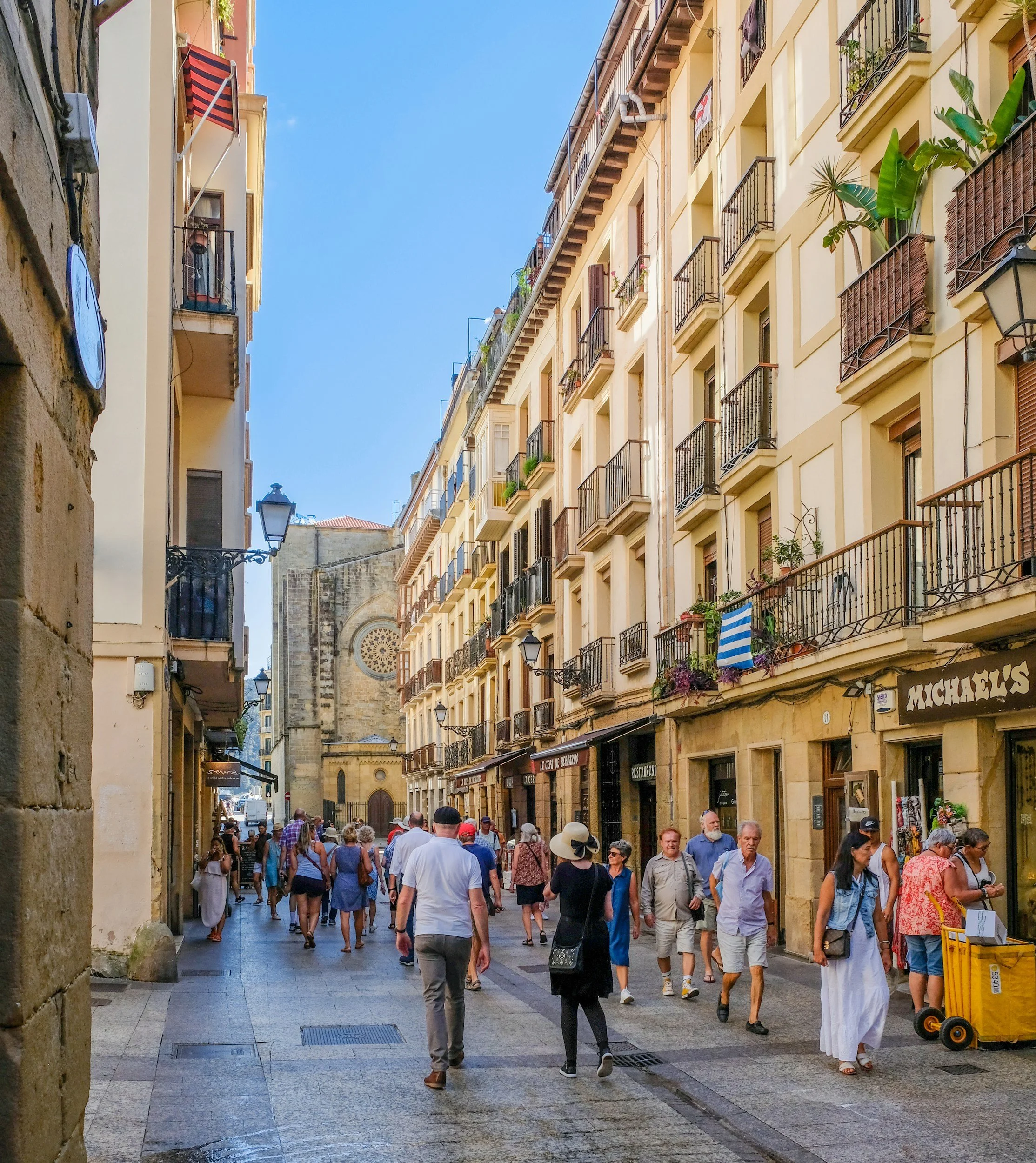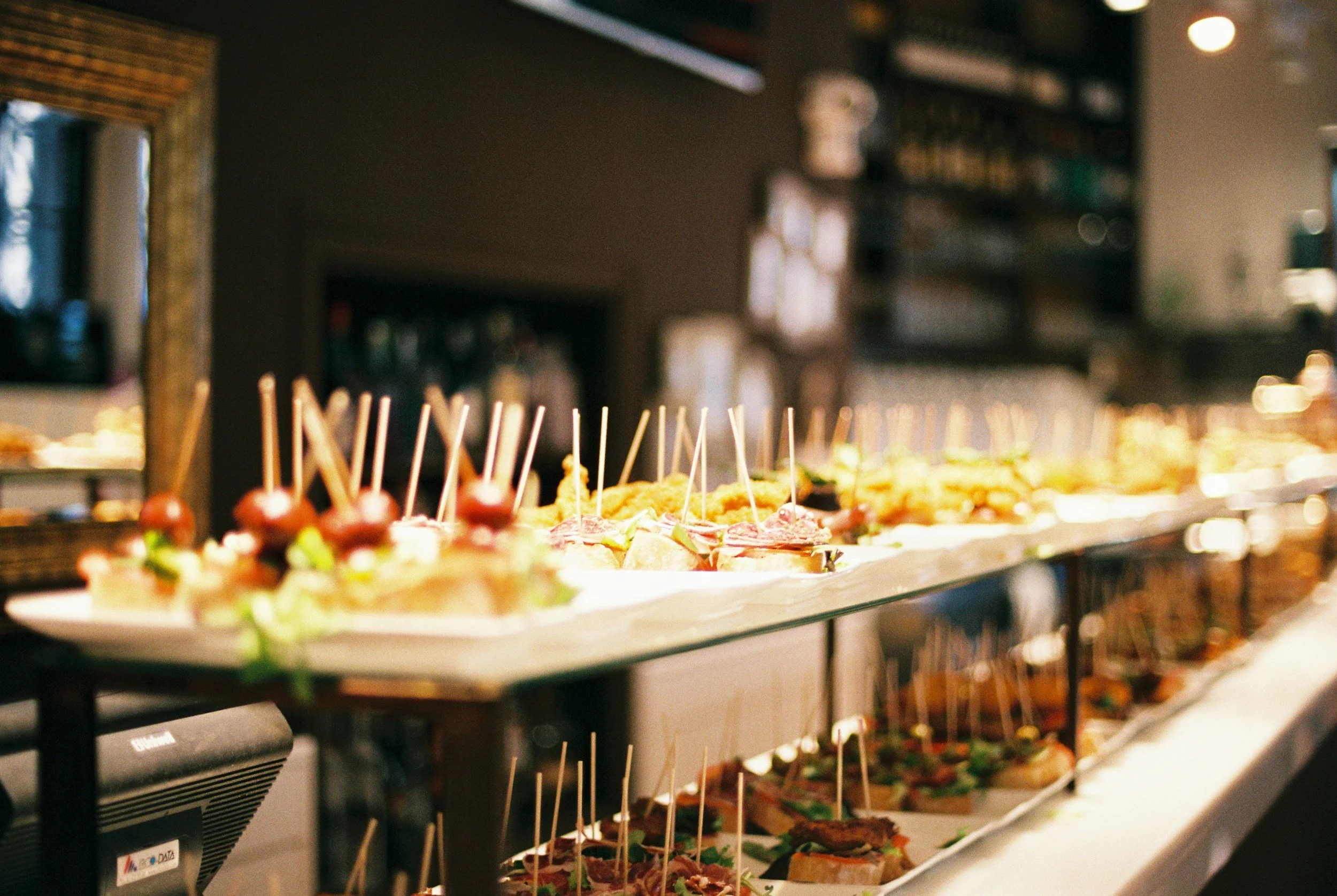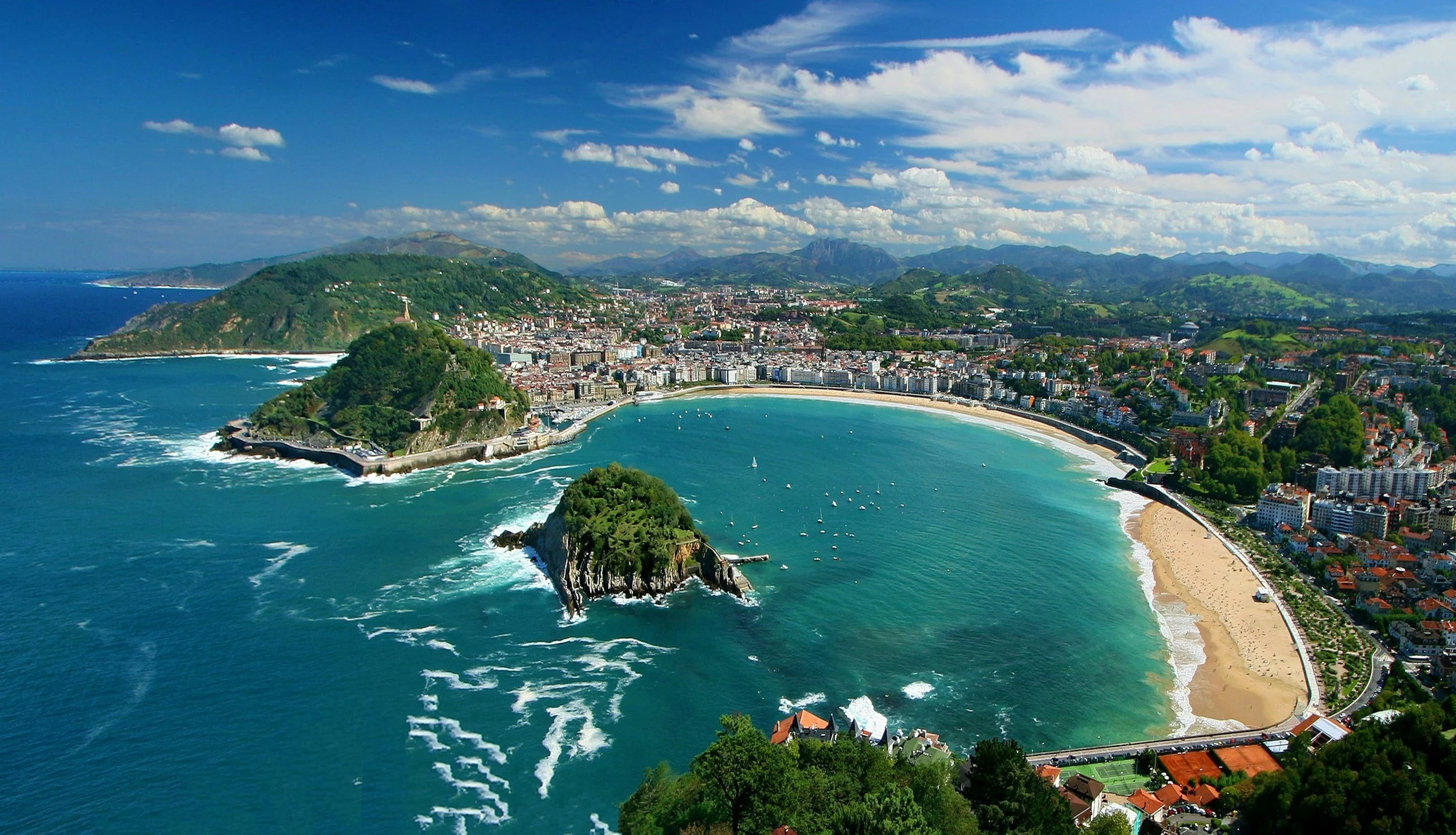Eat Like a Local in San Sebastián: Pintxos, Michelin Stars and Basque Food Culture
San Sebastián isn’t just a beach town with a pretty face — it’s one of the world’s most revered food destinations. Tucked into Spain’s Basque Country, this coastal gem punches far above its weight in culinary prestige, with more Michelin stars per capita than almost anywhere else on the planet. But it’s not all white tablecloths and tasting menus. What makes San Sebastián truly magical is how its fine-dining flair lives side-by-side with humble pintxos bars, crowded cider houses, and lively food markets.
Locals here don’t just eat — they celebrate food like a religion. Whether it's bar-hopping through the cobbled streets of the Old Town for bite-sized masterpieces on bread, or sipping txakoli (a fizzy white wine) over plates of spider crab or marmitako, eating in San Sebastián is as much about ritual as it is about flavour.
Here’s how to eat like a local — from the pintxos etiquette to the hidden gastronomic gems only the Basques seem to know.
Pintxos Culture in the Old Town
San Sebastián’s Old Town — known locally as Parte Vieja — is ground zero for pintxos culture. These small, artfully crafted snacks are the Basque answer to tapas, but with their own proud identity, traditions and flair. While tapas are often shared at the table, pintxos are made to be grabbed, savoured, and followed by a quick move to the next bar. It’s not just a meal — it’s a social circuit.
What Are Pintxos?
Pintxos (pronounced peen-chos) are typically bite-sized snacks served on small slices of bread and skewered with a toothpick — though many modern versions ditch the bread and are plated individually. Expect combinations like anchovy and pickled pepper (Gilda), grilled foie gras with apple compote, or perfectly seared beef with local Idiazabal cheese. While traditional pintxos sit on the bar for self-service, many bars now serve hot options made to order — so don’t just eat with your eyes.
How to Order Like a Local
Skip the menu — look at the bar and ask what’s fresh. Locals often order one pintxo and one drink (txikito of wine or a splash of txakoli), eat standing at the bar, and then move on. It’s called a txikiteo — the Basque version of a bar crawl, focused entirely on food and drink. Don’t hoard a table or overstay your welcome at one place. Instead, enjoy the buzz, take a bite, sip something crisp, and roll out to the next spot.
World Locals Tip: You can usually just tell the bartender what you took from the bar — they trust you. But if ordering hot pintxos, ask for recomendaciones del día (recommendations of the day) to try something seasonal.
Top Pintxos Bars to Try
Borda Berri – Known for melt-in-your-mouth veal cheeks (carrilleras) and inventive hot pintxos. No bread in sight, just serious flavour.
La Cuchara de San Telmo – A local favourite for elevated pintxos like slow-cooked pork and duck confit. It’s tiny, chaotic, and unforgettable.
Gandarias – The go-to for top-quality traditional pintxos. Try the solomillo (sirloin) with green pepper — pure simplicity, done perfectly.
Bar Néstor – Famous for just five items on the menu. Come early to reserve a slice of their legendary tomato salad and tortilla — both sell out fast.
Txepetxa – Anchovy lovers, rejoice. This spot specialises in anchovies prepared a dozen different ways, from blueberry sauce to sea urchin.
San Sebastián’s Michelin-Starred Scene
For a city with fewer than 200,000 people, San Sebastián’s culinary credentials are staggering. It’s one of the few places in the world where you can casually surf in the morning and sit down to a three-Michelin-starred tasting menu by nightfall. The Basques have always taken food seriously — but here, culinary artistry is elevated to something almost sacred.
A Culinary Capital of the World
San Sebastián is home to three restaurants with the coveted three Michelin stars: Arzak, Akelarre, and Martín Berasategui. That’s not to mention a constellation of one- and two-starred gems scattered across the region. These aren’t just flashy titles either — many of these chefs are pioneers in molecular gastronomy, seasonal foraging, and reinventing traditional Basque recipes in totally new ways.
World Locals Tip: Michelin dining here doesn’t feel stuffy — many chefs were born and raised in the region, and the warm Basque hospitality shines through even in the most refined spots.
Must-Know Restaurants
Arzak – A Basque institution run by Juan Mari Arzak and his daughter Elena. Known for its innovative dishes rooted in local ingredients. Think beetroot dust, edible rain, and plates that surprise without pretension.
Akelarre – Perched above the coast, Pedro Subijana’s Akelarre blends Basque culinary tradition with panoramic sea views. Their tasting menus are works of art.
Martín Berasategui – Located just outside the city in Lasarte-Oria, this restaurant holds three Michelin stars and has a near-mythical reputation for creative, beautifully balanced cuisine.
Can You Dine Michelin on a Budget?
Absolutely — especially at lunch. Many Michelin-starred restaurants in San Sebastián offer multi-course tasting menus at lunchtime for a fraction of the dinner price. Expect to pay around £80–£110 (€95–€130) for a lunch menu — not cheap, but remarkable value for a world-class experience.
For even more budget-friendly options, check out:
Narru – A stylish spot with refined Basque cooking, located in Hotel Arbaso.
Zazpi STM – Contemporary pintxos with gourmet flair at everyday prices.
Topa Sukalderia – From the team behind Mugaritz, this playful kitchen blends Basque and Latin American flavours.
San Sebastián Old Town.
Traditional Basque Dishes to Try
San Sebastián might be best known for pintxos and Michelin stars, but the soul of Basque cuisine lives in its traditional dishes. Rich in local seafood, mountain produce and hearty flavours, these recipes have been passed down through generations and are still found on the menus of family-run taverns and modern kitchens alike.
Bacalao al Pil Pil
This classic dish of salt cod in a silky garlic and olive oil emulsion looks deceptively simple — but the technique is everything. The key? The natural gelatin from the cod emulsifies with the oil, creating a creamy, almost aioli-like sauce without a drop of cream. Best enjoyed with crusty bread and a glass of white wine.
Txangurro (Spider Crab)
A delicacy from the Bay of Biscay, txangurro is spider crab meat sautéed with onion, tomato, brandy and a hint of spice, then baked back in its shell. Rich, warming, and deeply coastal, it’s a Basque festive favourite — but you’ll find it in seafood restaurants all year round.
Talo con Chistorra
This rustic snack is the Basque answer to a sausage roll. Talo is a cornmeal flatbread (similar to a tortilla) filled with sizzling chistorra, a smoky, paprika-spiced sausage. Often served at markets and festivals, it’s one of the most comforting street foods around.
Marmitako
This hearty fisherman’s stew hails from the Basque coastline and is typically made with bonito tuna, potatoes, peppers and onions in a light tomato broth. Originally a humble meal cooked onboard boats, today it’s a nostalgic dish that blends simplicity with depth.
Cheesecake from La Viña
Yes, it’s become Insta-famous — but it still lives up to the hype. The burnt Basque cheesecake from La Viña is creamy, caramelised perfection. Unlike dense American versions, this one is light, slightly jiggly in the middle, and served plain — no toppings needed. You’ll find copycats around the globe, but this is the original.
World Locals Tip: Head to La Viña in the late afternoon to avoid the queues, and grab a slice with a glass of sweet sherry. It’s not a local pairing, but it hits the spot.
What to Drink
Food may take centre stage in San Sebastián, but what’s in your glass is just as essential to the local dining experience. Whether you’re clinking glasses during a pintxos crawl or sipping something crisp over seafood, drinks here are more than just an accompaniment — they’re part of the ritual.
Txakoli (Basque White Wine)
Slightly sparkling, dry, and wonderfully acidic, txakoli (pronounced cha-ko-lee) is the go-to pairing for pintxos. It’s made from indigenous Hondarrabi grapes and served with a dramatic high pour — not just for flair, but to aerate the wine and boost those lively bubbles. Expect notes of citrus, green apple, and sea spray — the perfect refreshment after a day wandering the Old Town.
World Locals Tip: Ask for Getariako Txakolina — a top-quality variety from nearby Getaria. And don’t be surprised if the bartender pours it from above their head — it’s tradition.
Sidra (Basque Cider)
Basque cider is a whole different experience from the sweet commercial ciders you might be used to. Unfiltered and sour, sidra is earthy, funky, and often served straight from the barrel. Many locals visit traditional sagardotegis (cider houses) just outside the city, where the meal centres around cider-pouring rituals and hearty dishes like steak, cod omelette, and cheese with quince.
How to drink it like a local: Stand near the barrel, catch the stream mid-air into your glass (the higher the pour, the better the fizz), then drink it fast — it loses its sparkle quickly.
Local Red Wines from Rioja Alavesa
Though not technically in Basque Country, Rioja Alavesa is just inland and provides some of the best reds in Spain. These wines are elegant and balanced — ideal for richer dishes like carrilleras (veal cheeks) or txuleta (bone-in ribeye steak). You’ll also find reds from Navarre and even up-and-coming Basque producers experimenting with new varietals.
Try this: Ask for a glass of Tempranillo or Garnacha from the region to level up your pintxos pairing.
How to Eat Like a Local
Eating in San Sebastián isn’t just about what’s on the plate — it’s about how you enjoy it. Locals take pride in their rituals, from the casual pintxos crawl to the deeper cultural traditions tied to food. If you want to blend in, follow these unwritten rules and savour the experience like a true donostiarra (local of San Sebastián).
Join a Txikiteo (Bar Crawl)
Locals rarely sit down to a full meal of pintxos at one bar. Instead, they txikiteo — a bar-hopping ritual where you grab a single pintxo and a small drink at each stop. Think of it as a mobile tasting menu with good company, changing scenery, and no need to commit to one table. Groups move between bars chatting, sipping, and comparing bites along the way.
Pro tip: Don’t stay too long at any one bar — two pintxos max before moving on.
Skip the Fork and Use a Toothpick
Pintxos are meant to be eaten casually, often with fingers or a cocktail stick. Unless it’s a hot pintxo served with cutlery, avoid over-complicating things. Grab it, eat it standing up, and wash it down with a quick sip of cider or txakoli.
World Locals Tip: If you’re picking from the bar counter, save your used toothpicks — some bars count them at the end to tally up your bill.
Visit a Local Gastronomic Society (if you can)
One of San Sebastián’s most fascinating culinary traditions is the txoko — private gastronomic societies where members gather to cook, eat, and socialise. Some date back over a century and are fiercely local, but a few offer events or classes for curious outsiders. They’re not restaurants, but the food, camaraderie and authenticity are unforgettable.
Best Food Markets: Mercado de la Bretxa
To truly understand what fuels this city’s kitchens, head to La Bretxa Market in the Old Town. Chefs from top restaurants shop here daily for local produce, seafood, meats and cheeses. Even if you’re not cooking, it’s worth wandering through for the smells, colours and regional specialities — think salt cod, wild mushrooms, and glistening anchovies from the Cantabrian Sea.
Pintxos.
Foodie Tips and Hidden Gems
Even in a city as culinary-famous as San Sebastián, there are still tricks to eating well and spots that fly under the radar. Whether you’re here for a weekend or a week, these tips will help you dodge the tourist traps and unlock more authentic local flavours.
Avoid Overcrowded Tourist Bars
Some pintxos bars in the Old Town look incredible — piles of vibrant snacks stacked high on the counter — but often these are the most touristy. Locals tend to skip the flashy displays in favour of bars that cook made-to-order hot pintxos or specialise in one or two key dishes. If it’s packed with camera-wielding tourists and menus in five languages, it’s probably not where locals go.
World Locals Tip: Peek inside before committing — if you hear mostly Spanish or Euskara (Basque), you’re on the right track.
Ask the Bartender for Seasonal Specials
Many bars don’t list their best dishes on a menu — especially if they’re using seasonal ingredients. It’s always worth asking ¿Qué me recomiendas? (What do you recommend?) or ¿Qué hay fuera de carta? (What’s off-menu?). You might get something unforgettable: grilled wild mushrooms in autumn, baby squid in ink sauce in summer, or even a cheeky shot of local digestif to finish.
Go Pintxos Hopping Early
The best bars fill up quickly — especially between 8 and 10pm. If you want elbow room at the bar (and the freshest bites), start your evening pintxos crawl around 7pm. Locals eat late, but this early hour gives you prime access before the crowds surge.
Don’t Miss the Gros Neighbourhood
While the Old Town gets all the fame, Gros — across the river — is where the next-gen pintxos movement is thriving. It’s less crowded, more creative, and filled with places where young chefs are experimenting with new flavours while keeping Basque identity intact. Check out:
Bar Bergara – Beloved for traditional favourites and innovative combos.
Casa Senra – Inventive, generous pintxos with a friendly vibe.
Zabaleta – Known for their tuna-stuffed piquillo peppers and anchovy creations.
When to Visit for Food Festivals
San Sebastián celebrates its culinary culture all year long, but if you time your trip right, you’ll land smack in the middle of a foodie festival that takes things to the next level. These aren’t just events — they’re deep-rooted traditions where food, drink, music and community come together in true Basque style.
Tamborrada (20 January)
San Sebastián’s biggest party of the year kicks off at midnight on 19 January. What begins as a 24-hour drum parade to honour the city’s patron saint quickly becomes a city-wide feast. Locals in chefs' outfits and soldiers’ uniforms march through the streets while restaurants put out their best dishes. It's one of the most unique ways to experience the local culture — and yes, there’s plenty of food involved.
World Locals Tip: Book accommodation well in advance — this is one of the city’s busiest weekends.
Semana Grande (Mid-August)
Also known as Aste Nagusia, this is San Sebastián’s epic summer festival. It runs for a week and features nightly fireworks, open-air concerts, and a flood of food stalls along the promenade. Expect an informal atmosphere, lots of street food (from grilled chorizo to churros), and an ideal setting for pintxos crawling from beach bar to backstreet gem.
Basque Gastronomy Fair (Dates vary)
Keep an eye out for pop-up events and seasonal markets like the Basque Gastronomy Fair (Euskal Gastronomia Azoka) which showcases local producers, chefs, and winemakers. Often held in spring or autumn, these events feature cooking demos, artisan food stalls, and the best opportunity to sample regional specialities all in one place.
San Sebastián.
San Sebastián isn’t just a place to eat — it’s a place to experience food as a way of life. Whether you’re balancing a pintxo and glass of txakoli in a buzzing bar, lingering over a multi-course tasting menu, or slurping cider in a countryside sagardotegi, you’ll quickly see that here, meals are moments — rich with culture, community and pride.
To eat like a local in San Sebastián is to tap into a rhythm of life that’s unhurried but deeply passionate. Every bite has a backstory, every pour a purpose. And whether you're hunting down anchovy masterpieces in a backstreet bar or chasing the latest Basque twist on cheesecake, you’re part of a culinary tradition that’s both rooted and revolutionary.
So loosen your belt, sharpen your appetite, and hit the streets. The Basque Country is calling — and it smells incredible.



